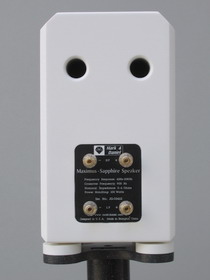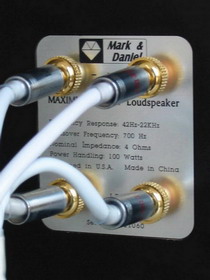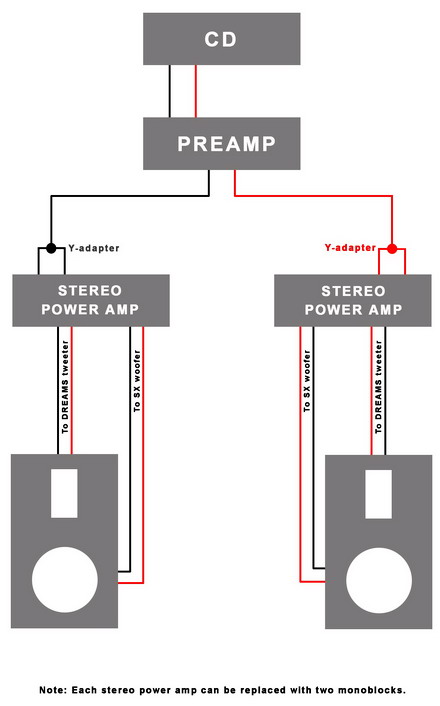Q: Why M&D considers the bi-amp system is the best approach for driving M&D speakers? How do I properly build a bi-amp system, and if the electronic crossover equipment is needed here?
A: No electronic crossover equipment is needed here for the bi-amp system since bi-wire speakers have already the build-in crossover networks inside.
Bi-amp driving system, means with two amplifiers in parallel connections to drive the 2-way speaker (while equipped the bi-wire binding posts), to the HF (tweeter) and LF (woofer) drivers separately.
 
Most of M&D speakers are having the bi-wire design so may be used for bi-amp configuration to double up power and improve sonic quality as a common knowledge to audiophiles.
However, typical 2-way bi-wire speakers are designed with crossover point too high that the mid-range/bass driver is taking up most of the task. Such design degrades the real benefit of bi-amplification;Therefore, not so common that recommended by most of speaker makers.
On the other hand, due to the low crossover design (typically at 800Hz), enables M&D’s Dreams AMT wideband driver and the SX woofer each shares the 4 to 5 octaves frequency band during sound reproduction to the complete audio spectrum; the advantages of a bi-amp system may be maximized to incorporate with M&D speakers!
Theoretically, if one speaker requires a 100W amplifier per channel for proper drive; then, only 1/4 (i.e. 25W per channel) output power is required from each amplifier under the bi-amp connections. However, M&D suggests a better ratio in between 30% to 50% (i.e. 30W to 50W per channel) for suiting music source varieties with best dynamics during reproduction.
To the market, conventional high power (above 100W output per channel) stereo amplifiers are normally quite expensive, for proper drive M&D speakers; on the other hand, with the more affordable 30W to 50W mid-power amplifiers to build a bi-amp configuration, may be a best solution to get more economical, better sound performance hi-fi system.

M&D recommends a bi-amp configuration is as the attached diagram.
- It is preferable that your pre-amplifier is having the two parallel RCA outputs; however, you can use the Y-adaptor cable to split for two inputs to the power amplifiers since most of pre-amps do not have two outputs.
- A vertical bi-amp connection (i.e. one stereo amp to share between tweeter and woofer for one channel) is recommended for your stereo power amp; since the woofer normally drains more power from the amplifier than the tweeter, so the power supply of the stereo amplifier can share more current to the woofer’s side, by this way of connection.
- Each stereo amplifier may be replaced with two monoblocks (or, digital amplifier) that is getting more popular today. Someone may consider using different power monoblocks (e.g. 30W for tweeter and 50W for woofer) to the bi-amp system; however, this is not applicable here since different amplifiers have normally different voltage gains, thus, creates not equal driving to the already aligned bi-wire speaker. Two identical monoblocks to each channel is required!
Here is the detail instructions that how to properly connecting your bi-wire speaker with the bi-amp system while your pre-amp has only one RCA outout:
1) From the preamp output, you have L signal and R signal leading out from a pair of RCA interconnect cables. Do not connect the cables to the power amps yet. Get two Y-adapters (a short interconnect cable with one female socket on one end and two male plugs on the other.) Plug L signal into the female socket of one Y-adapter. Plug R signal into the female socket of the second Y-adapter. Now you get two LEFT signals and two RIGHT signals. If you are using two stereo integrated amps (in stead of preamp and power amps), use the same method to spit the signals from your source equipment.
2) Connect the two LEFT RCA signals to the L and R inputs of the first stereo amp, which becomes your L channel amp. (It does not matter what they are marked L/R channels, since they have now both accepted the same signal.) Then connect the two RIGHT RCA signals to L and R input of the second stereo amp, which now becomes your R channel amp. Same idea for the monoblocks or digital amplifiers.
3) Connect the first set of speaker binding posts on your L channel amp to the HIGH Frequency speaker binding posts of your bi-wire speaker. Next connect the second set of speaker binding posts on your L channel amp to the LOW Frequency speaker binding posts of the same bi-wire speaker. You can use two pairs of speaker cable for connections; or more convenient, use the bi-wire speaker cable to each channel.
4) Repeat the same with the R channel amp and the other bi-wire speaker. [ BACK ]
|
